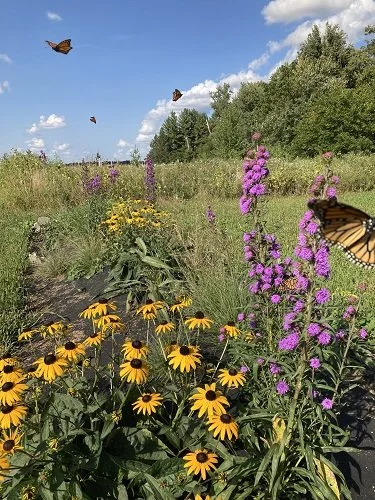How would you like to add more peace and calm to your life with a native pollinator garden?
Since you’re an environmentally conscious consumer, a gardener, and a busy mom who just needs a moment of peace once in a while, I thought you might be interested to see how we created this pollinator and monarch butterfly magnet in one growing season.
I’m always thinking about ways to add more native plants to the farm, and this was a great way to make some quick progress right in our backyard.
Spring is starting to take hold, so now is the time to think about putting this plan in place.
You can transform a little strip of ground into a perfect quiet space to escape the distractions of your day. Imagine a uniquely attractive display with monarch butterflies hovering around quietly over multiple colors of native flowers. What a peaceful place to melt away your worries.
I had no idea monarchs would be attracted to this so quickly. This little flower bed attracted a much bigger concentration of monarchs than we typically see at the farm.
The best part is, this is not hard to do, and it can happen quickly.
This monarch bed was originally intended to be a hügelkultur for growing vegetables, but that ended up being a somewhat miserable failure on my part. A hügelkultur is basically a raised garden bed with the core being made up of rotting wood. Long story short, I think the wood I used wasn’t rotted enough.
After a few years of trying to work with the hügelkultur, we decided to repurpose it into a native pollinator plot.
We chose to order a pollinator garden kit from Blazing Star Gardens in Owatonna. The kit contained an assortment of 54 flowers and 18 grasses. All of which were selected for their attractiveness to pollinators and beneficial insects. The main attraction for monarchs being meadow blazing star. The plants were shipped to us as “plugs” (started plants) in a flat to be planted individually.
Using these plugs makes the process easy compared to establishing native plants with seed. Using seed has its benefits, especially for bigger areas, but the seed bed preparation has to be just right with very little weed pressure and then it takes a good three years of care to get the seeding fully established.
Weed control becomes simple with plugs. We just laid down landscape fabric over the existing ground, and planted the plugs through holes we cut in the fabric. If you have established grass sod to deal with, I would recommend killing that first, but we had already taken care of that when we built the hügelkultur. Weeding is quick and easy with this method. The landscape fabric will take care of the annual weeds between the plants, so all you have to do is weed around each plant.
One thing to be extra diligent with when using plugs is water. Since these plants are already started, they have a higher water requirement, and until their root systems get established in their new home, they are very prone to drying out quickly. Frequent watering will be needed for the first year. The year we planted our plugs, was very wet in the spring, so we didn’t need to water much. Then the fall turned into a drought, and we did end up loosing a few plants because we didn’t water often enough.
We planted our plugs in May and by late summer we already had beautiful blooms on many of the plants. Enough that they were full of monarchs in September. Although the plants are not yet fully established it was gratifying to see such quick results, and it always amazes me how fast nature can respond to a little bit of love. In year two of this planting, I expect to see these plants become fully established and fill out the bed.
One added benefit of this pollinator and monarch magnet is that it doubles as a beetle bank.
Remember I said that our spot was originally built as a hügelkultur, so it is raised in the middle, and our pollinator kit includes native bunch grasses. These are two key ingredients for a beetle bank. A beetle bank consists of bunch grasses where beneficial beetles nest. Because they are on ground that is slightly raised, it drains well and keeps the beetles dry. The beetles will range out long distances from their home to prey on insect pests in our nearby vegetable gardens.
So, we have home beautification, pollination, habitat for threatened species, and natural pest control for the garden all in one simple planting.
Happy planting,
Herman




